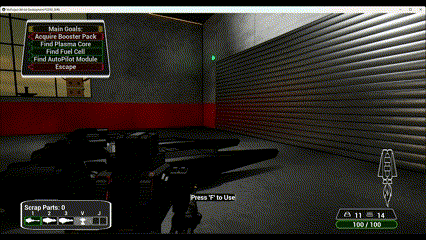Raymond Hobble
Game Designer
Rogue Cybernetics Postmortem
Introduction: This Postmortem will be discussing a project I worked on, Rogue Cybernetics. The gameplay revolves around a recently awoken AI player that must escape the island facility it was created on. A mysterious stranger guides the player as the traverse the island in search of the items needed to make their escape using an incomplete ship.
What Went Right
Escape Ship Implementation: The escape ship was an interesting experiment in combining code and cinematics for a cool exit cutscene at the end of the game. I used a combination of timelines (for the opening of the hangar door and the take off of the ship) and a cutscene cinematic to follow the movement of the ship as it took off. This was my first attempt at creating a cutscene and was extremely successful.

HUD Design: The HUD was a lot of fun to create. I learned several new skills during its implementation. One of the player attacks has a cooldown, and I learned how to share that with the player through the HUD in the form of a tab for that ability that empties upon its use and then slowly refills. I used a similar method to show the player how close they were to overheating the jetpack, which would cause them to stop using it and have to wait for it to cool before using again. The large amount of information I had to relay to the player regularly required me to focus on how much screen real estate each element of the HUD needed to occupy. It was also important to make sure that the HUD elements would not blend in with other content and be lost to the player while also ensuring that the player would not be overly distracted by the HUD.

Journal Creation: The journal was a late addition to the game. Its purpose was to record all previously encountered tips so that the player could review them later as needed. It also contained a how to page that served to remind players of controls should they need it. While making the journal, I rebuilt the original tip mechanic to work better with the journal and optimize it. After two iterations, I successfully created a journal that playtesters felt was easy to use and appealing to look at.

Win Screen Evolution: The Win Screen began as a simple message informing the player that they have won and asking if they would like to play again. A member of the team approached me and asked if I could design a mechanic that would track how long it took the player to progress through various parts of the map as well as several other variables so that he could use that information for playtesting and balancing purposes. I implemented the mechanic and took it a step further, adding additional content to the win screen. Now the player received statistics for their trip through the game. I determined that it would add replay value for the player to have goals to beat previous scores received.

What Went Wrong
Booster Pack Inconsistency: The booster pack mechanic was rife with issues in the beginning. Determining the best stats to use for a balanced feel without being over-powered was challenging. There was an issue where the booster pack worked differently depending on the system being used. After this was initially corrected, a new issue of similar nature occurred based on the graphics setting used during play.

Blockmesh to Finalized Asset Transition: The transition from blockmesh to finalized assets was challenging. The primary cause of the difficulty was fact that the finalized assets were at a different scale than the blockmesh. Because of this, levels had to be adjusted. In most cases, this meant that the levels increased in size slightly, though there were a couple areas that shrank in size. This was not a big problem, but it did require the mechanics and other level elements to be resituated to make better sense with the changes.
Boss Battle in Final Elevator: The final elevator connecting the end and beginning of the map also served as the location of a final boss battle. However, it was originally designed to teleport the player from the end location to the beginning location, which would trigger the boss spawning. This teleportation was very noticeable and unappealing. I updated the elevator, making it a true elevator rather than a teleporter and having the boss spawn in when the elevator reached its destination. In retrospect, if I were to change anything, I would have kept the original teleport concept and used a cutscene showing the appearance of the boss enemy to hide that the teleport happened.
Conclusion: Rogue Cybernetics served as an excellent game to improve my UI design skills while also practicing the development of new mechanics for gameplay. While there were a few struggles, it was a primarily positive experience with significant growth. From learning new and interesting ways to manipulate the player HUD to gaining valuable practice with the creation of cutscenes and mechanics, this game has been a fun and challenging addition to my portfolio.